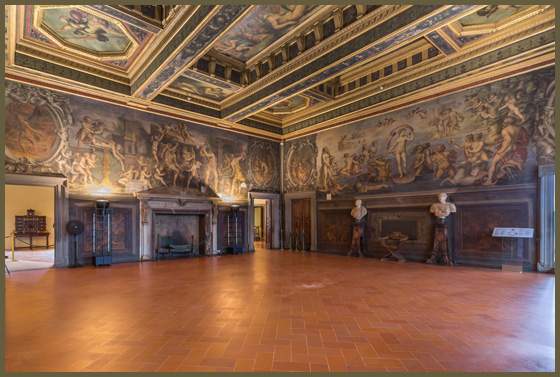Florence, after two years ends restoration of Sala degli Elementi in Palazzo Vecchio. Made possible thanks to private funding
In Florence, restoration work on the Hall of the Elements in the Palazzo Vecchio is finished, and after two years it is therefore fully usable again. The Sala, which is located at the beginning of the Quartiere degli Elementi (on the third floor of the city’s landmark building), was recovered thanks to a private grant of about 800,000 euros, guaranteed by the Giulio and Giovanna Sacchetti Onlus Foundation: with their support it was possible to work on the frescoes on the walls and ceiling of the Hall of the Elements (with costs of 475 thousand euros for the walls and 318 thousand euros for the ceiling), the subject of the intervention directed by the Fine Arts Office of the Technical Services Directorate of the City of Florence and carried out by the firms Mannucci srl, Meridiana Restauri srl and Techne snc. Two years of work were required, during which, however, the public was still able to access the room, since the restoration site was designed so as not to alter the visiting route (indeed, through special scaffolding the public was able to see the restorers at work and observe the ceiling frescoes up close).
The Quarter of the Elements represents the most important intervention in Palazzo Vecchio by Cosimo I de’ Medici (Florence, 1519 - 1574), first duke of Florence and then, from 1569, grand duke of Tuscany: composed of five rooms and two loggias, the quarter was decorated by various artists after the disappearance of Battista del Tasso (Florence, c. 1500 - 1555), to whom the undertaking had initially been entrusted. The Hall of the Elements, in particular, consists of frescoes (done first by Battista del Tasso and then by Vasari and workshop) alluding to the four elements:Water (with the Birth of Venus), Earth (the Firstfruits of Earth offered to Saturn), Fire (the Forge of Vulcan) andAir (in the ceiling, with Saturn mutilating the sky). At the base of the frescoes, there are panels frescoed by Marco Marchetti (Faenza, c. 1528 - 1588) with scenes of battles between sea gods, while the fireplace was made to a design by Bartolomeo Ammannati (Settignano, 1511 - Florence, 1592).
The intervention had become necessary to remedy the steadily accelerating state of deterioration in which the room was deteriorating, leading to various problems: for example, in some portions of the frescoes the pictorial film was in danger of peeling off (the pieces most at risk had already been veiled), and in others there was the effect of wet perculations. After a diagnostic campaign and a careful analysis phase, restorers therefore preconsolidated the pictorial film with acrylic resins and injection mortars, an operation that was followed by cleaning all surfaces with deionized water. They then went on to apply ammonium carbonate compresses to remove the old consolidating substances, and absorbent compresses with sepiolite, arbocel and a very low concentration of saturated water. It was also necessary to remove the old grout and make new grouts with desalinized hydraulic lime-based mortars mixed with sand. Stuccoes that were still functional were preserved but lowered in tone. The final retouching was done with natural earths and oxides, diluted in ammonium caseinate: abrasions were treated through tone lowering to transparent color glazes, while the integration of gaps was done through color selection.
The ceiling required further attention because of moisture infiltration, which had caused swelling and pulverization and of the preparatory layers, resulting in the lifting of the pictorial film or gold leaf used by Cosimo I’s painters. They therefore proceeded with an initial cleaning that removed substances added in later periods, for example in more recent restorations (such as the one carried out between 1949 and 1951), during which the frescoes were covered with protective varnishes and fixatives that had altered over time, and then continued with consolidation on the panels and frames. The restorers then removed the decohesive glazing and plastering, and then proceeded with a new plastering of the missing and deteriorated portions. The cleaning was differentiated according to the pictorial techniques used: in the tempera grassa panels, three types of differentiated cleaning were performed so as to gradually thin the altered overpainting, while in the frames the cleaning was differentiated with two methodologies according to the different decorations, using PH-controlled solutions. Pictorial reintegration in the plasterwork was carried out with paint and tempera colors using the “undertone” and “chromatic selection” methodology, and at the end a surface varnish was applied to the boards partly by brush, partly by misting, so that the pictorial reintegrations were homogeneous with the original.
The restoration, they let the City of Florence know, was also an opportunity for a critical reflection on the methodologies developed by the discipline of conservation over the past fifty years, for example, reducing to a minimum the use of barium hydroxide as a consolidating agent for frescoes, favoring the use of state-of-the-art findings such as nanocalci and favoring the use, in conservation processes, of environmentally friendly materials.
 |
| Florence, after two years ends restoration of Sala degli Elementi in Palazzo Vecchio. Made possible thanks to private funding |
Warning: the translation into English of the original Italian article was created using automatic tools. We undertake to review all articles, but we do not guarantee the total absence of inaccuracies in the translation due to the program. You can find the original by clicking on the ITA button. If you find any mistake,please contact us.





























